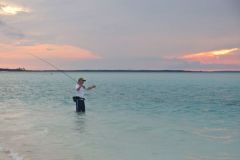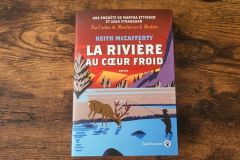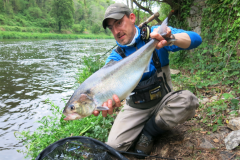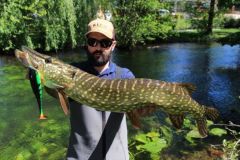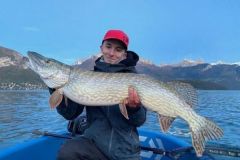Knowledge of life cycle and seasonal migration
Pike, like all fish, have a very particular life cycle which it's important to know in order to know where, when, how and with what tackle to fish.
Throughout the season, pike will move or migrate within their living environment, depending on the season (water temperature) but also to follow their food source and of course for their reproduction, which takes place in shallow (flooded) areas rich in aquatic vegetation where the (sticky) eggs will be deposited.
After spawning, which in France generally takes place in February and March, with variations of course due to the climate of each region (water temperatures), our spawners set off in search of food, particularly large prey to restore their health, which makes them less wary and easier to catch.
It is also during this post-spawn period that many males suffer serious injuries, or even get swallowed up by the females, who always represent the largest fish. After a short period near their breeding grounds, they gradually migrate to warmer, often deeper waters, returning to the bays later when they have warmed up thanks to the spring sunshine.
When opening the second category, look for areas where aquatic vegetation is dense and well-developed, as many of our opponents will be able to find shelter and food there, even if it often happens, particularly in lakes, that they prefer the layer of water where the temperature is most pleasant. As luck would have it, this is where you'll also find roach, rotengill, bream and other whitefish, followed by perch, a major source of food for this species.
Observe your surroundings, especially at the surface, for signs of forage fish gobbling, eddies (cyprinid spawning) or other disturbances. If so, pike shouldn't be far away.
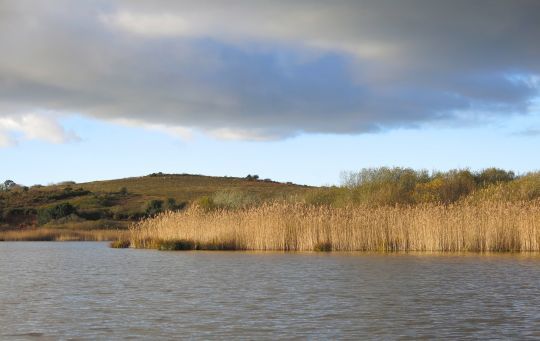
Pike camouflage and posture
Early in the morning, in May, pike will certainly be in deeper areas with higher temperatures, which should be combed as a priority. In the afternoon, once the water has warmed up, they will soon move up to shallower areas and enter the bays and edges to feed. Big fish will always have the best spots, whatever the species.
You need to know your territory well, and look for slope breaks, shoals, obstacles and other positions that are both close to the forage fish and offer a quality stalking post. Pike rarely pursue their prey. They camouflage themselves and then pounce on their target. Ideally, of course, you should be fishing from a boat or float tube, where the depth sounder will be invaluable in quickly locating positions and areas where food is concentrated. You'll then be able to prospect different types of spots and depths, and cover more ground than you would from the shore.
Look for water inlets, which often provide nutrients and therefore food for livebearers, but also areas that are sunny for a good part of the day, which will be slightly warmer. If the weather is mild and stable, conditions will be more favourable for our predators to be active and easier to find. However, at the start of the season, the slightest cold snap can push pike into lower layers, often further from the shore.
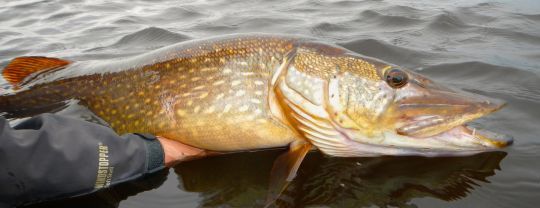
A few weeks later, when the waters have warmed up, they will spend some time on the edges where perch spawning, followed by cyprinids, will concentrate their prey, then, when other food sources appear, notably amphibians, rodents and any other potential prey.
Throughout the season, pike will follow their larder and seek out the layer of water where the temperature is most comfortable (thermal comfort). These daily movements will continue for as long as the water temperature fluctuates from one zone to another before reaching a thermal equilibrium. You'll need to follow their movements and adapt constantly to be effective and catch pike on a regular basis.
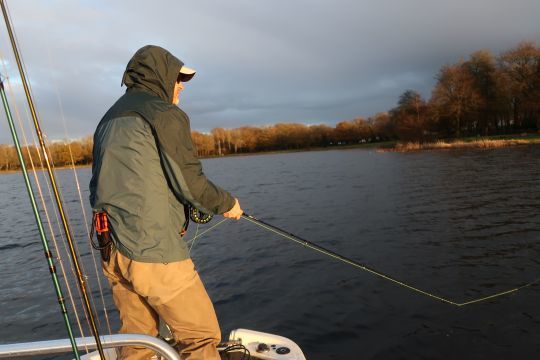
The right equipment
Today, it's possible to find numerous rods and, above all, specific lines that enable us to cover all situations and cast increasingly bulky and/or weighted flies at an interesting distance. Personally, I use semi-fast 9 and 10 power rods such as SAGE Payload, SAGE Maverick and the Redington Predator.
To be a complete pike angler, you need at least three types of line to cover all layers of water.
Depending on the position you're fishing, it's very important to use the right fly line, especially to get your fly to the right depth. Floating line is mainly used for late spring, summer and early autumn fishing, especially on the surface and sub-surface and in shallow ponds. In this case, a 40° brittle fluorocarbon leader finished with your 80 cm tippet (steel, fluorocarbon or titanium), all one rod length long, will be perfect.
An intermediate line (with a leader of about 2 m) will cover more than 60/70% of the situations you will encounter. It allows you to fish below the surface to a depth of 1.50 m, or even deeper if you reel in slowly or take breaks.
Plunging lines are necessary for deeper fishing if your stations are deep or in fast and/or deep rivers. A leader of 80 cm to 1.5 m is most often used.
During a fishing trip, if results are slow in coming, don't hesitate to change your line density, as the height of the water in which your fly is moving is of vital importance.
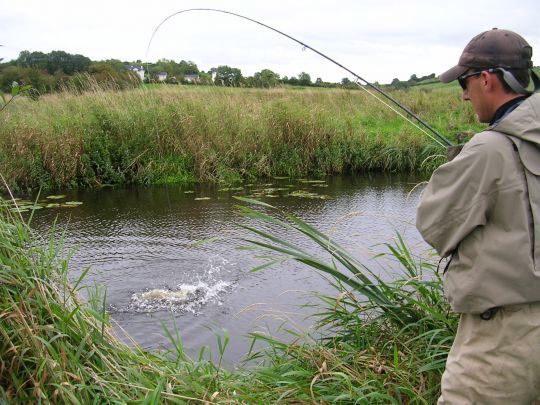
Fluorocarbon, titanium or steel?
Opinions differ on this point. Everyone chooses according to their preferences. Some say that fluorocarbon is unsuitable and not strong enough for big fish (used by very good big pike anglers in Holland), others that titanium is too stiff (widely used in the US), or that steel leaders keep their memory and shine in the sun (mostly used in France). Test and make your choice. They all work, and in my opinion should be selected according to conditions, flies and environment.
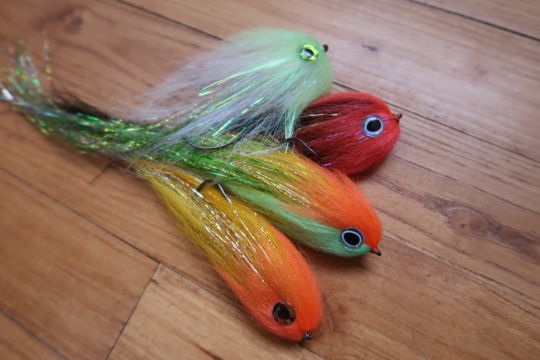
Flies for pike
The current fashion is to tie large flies (20/30 cm), or even tube flies to make a pike pale, coming to us from Scandinavian countries, but is it really necessary? Fishing with a large fly must be justified. This is often the case at the start of the season, particularly during bream spawning, and also in winter to interest fish looking for large prey with the least waste of energy.
The choice of fly is therefore crucial, in terms of profile, size, color and choice of materials, and must be adapted to the environment in which you fish. In all cases, it's a good idea to match the size of the prey at the time, but also to take into account water color and light conditions. When it comes to color, there are two main trends. Incentive flies, which are flashy and play on the aggressiveness of the fish, and realistic imitations, which are closer to the prey encountered, and therefore have natural colors.
Personally, I always start by fishing with colors often close to roach or perch, using flies of around 15 cm, which are the main prey in most of our environments. Unless the water is very cold or dirty, in which case I prefer a flashy chartreuse or fluorescent orange/yellow color. If nothing happens, I occasionally mount flies in brighter, more aggressive colors (red/white, fire-tiger, chartreuse, pink, etc.) even in clear water, or sometimes in larger sizes to provoke a reaction.
It's important to change flies if the results aren't there, in order to find the "pattern" of the moment or the day.
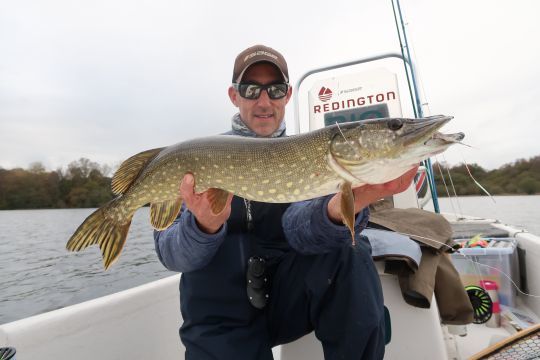
Finding the right animation
The animation of the fly will then come into play, as color is not always the only triggering factor. To achieve this, try every possible type of retrieve during your fishing trip. Try slow linear animation (especially in cold and/or tinted water), then fast to very fast (rolly poly) to trigger a reflex attack, or in between, or retrieves interspersed with long pauses, etc... The aim is to find what appeals to pike on that day, or even at that time of day.
At the start of the season, the still-cold temperatures will encourage us to fish rather slowly close to the bottom or obstacles, especially in the morning, taking breaks. The warmer the water gets during the day, the faster and/or more aggressive the action will have to be to trigger a bite. This doesn't mean you can't try everything and its opposite, which can sometimes pay off. It's not advisable to keep the same fly or animation type because you've caught a pike in this way, as during the day external factors change, such as light, water temperature, forage fish activity, and therefore the behavior of our predator as well.
Whether you're using a lure or a fly, it's this phase of research and testing that will give you the answers and enable you to adapt and succeed in catching the greatest number of fish. To sum up, you must always adapt to your game partner's clothing and diet, which fluctuate with the seasons. Vary the size, color and swimming depth of your flies according to environmental conditions (temperature, depth, water color, prey of the season) and constantly ask yourself the right questions about your strategy. You'll see it pays off in the end!




